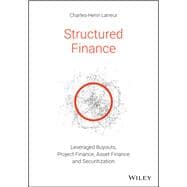Comprehensive coverage of all major structured finance transactions
Structured Finance is a comprehensive introduction to non-recourse financing techniques and asset-based lending. It provides a detailed overview of leveraged buyouts, project finance, asset finance and securitisation.
Through thirteen case studies and more than 500 examples of companies, the book offers an in-depth analysis of the topic. It also provides a historical perspective of these structures, revealing how and why they were initially created. Instruments within each type of transaction are examined in detail, including Credit Default Swaps and Credit Linked Notes. A presentation of the Basel Accords offers the necessary background to understand the regulatory context in which these financings operate.
With this book, readers will be able to:
- Delve into the main structured finance techniques to understand their components, mechanisms and how they compare
- Understand how structured finance came to be, and why it continues to be successful in the modern markets
- Learn the characteristics of financial instruments found in various structured transactions
- Explore the global context of structured finance, including the regulatory framework under which it operates
Structured Finance provides foundational knowledge and global perspective to facilitate a comprehensive understanding of this critical aspect of modern finance. It is a must-read for undergraduate and MBA students and finance professionals alike.








